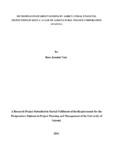| dc.description.abstract | The study sought to find out whether joint liability, service providers and transaction cost
determined smallholder farmer group lending by AFC. The study used survey method because it
sought to obtain information from the smallholder farmers that described the phenomena of
agricultural group lending by AFC. Besides, the survey sought to explain existing status of the
variables outlined under the research proposal. Primary data was collected using a structured
questionnaire which was in two forms: one for group members and another for the bank. Both
questionnaires were of closed ended questions that sought data to be analysed using quantitative
measures. Secondary data was obtained from client files and the Bank Equinox Based System
(EBS). Ninety six (96) out of 120 questionnaires administered to farmers were successfully filled
and returned back and this represented 80% return rate hence ensuring a close sample to the
original. The study found out that in as much as the finance institutions worked with farmers’
groups in raising agricultural production in Bura, there were several factors they considered in
lending to farmer which aimed at safeguarding the money they inject into farming activities to
ensure its repayment. Most of these factors hinder farmers from accessing credit either individually
or as a group from finance institutions due to their inability to provide the requisite collateral
requirements set by the lending institutions. Further, in Bura irrigation scheme, farming is the main
source of livelihood, the farmers practice agriculture on small scale and most of them do not have
the required collateral by lenders hence this further locks them out from accessing credit thus a
disadvantage to their growth and expansion. In this case, group lending is adopted to advance loan
facilities to farmers. It was deduced that to a larger extent joint liability determines as well
influences group lending in Bura irrigation scheme. Most of the tangible factors influencing group
lending in Bura Scheme had great effect on accessibility and loaning by AFC and other finance
institutions. Service providers were major determinants of group lending and their presence in
farmer groups encouraged banks and other financial institutions in availing credit to farmers and
this was found meet the Agricultural value chain required. Lastly, it was concluded that being in a
group reduced drastically the cost of transacting and processing loans as well as maintaining
loaning accounts. This was due to pooling of money together while in group hence not a
determinant to group lending by financial institutions and AFC. Following the findings, the study
recommended a revision of security of loans required by AFC to broaden it and ensure as many
farmers as possible are able to access loans, not only through group guarantee. Farmers should
strive to improve on their agricultural production through investing in quality seeds and
collaboration with service providers in order to increase collateral that can guarantee individuals.
Lastly, there is need of market guarantee by NCPB for commercial maize for the Bura farmers
since the farmers experience losses by selling locally to middle men. | en_US |



